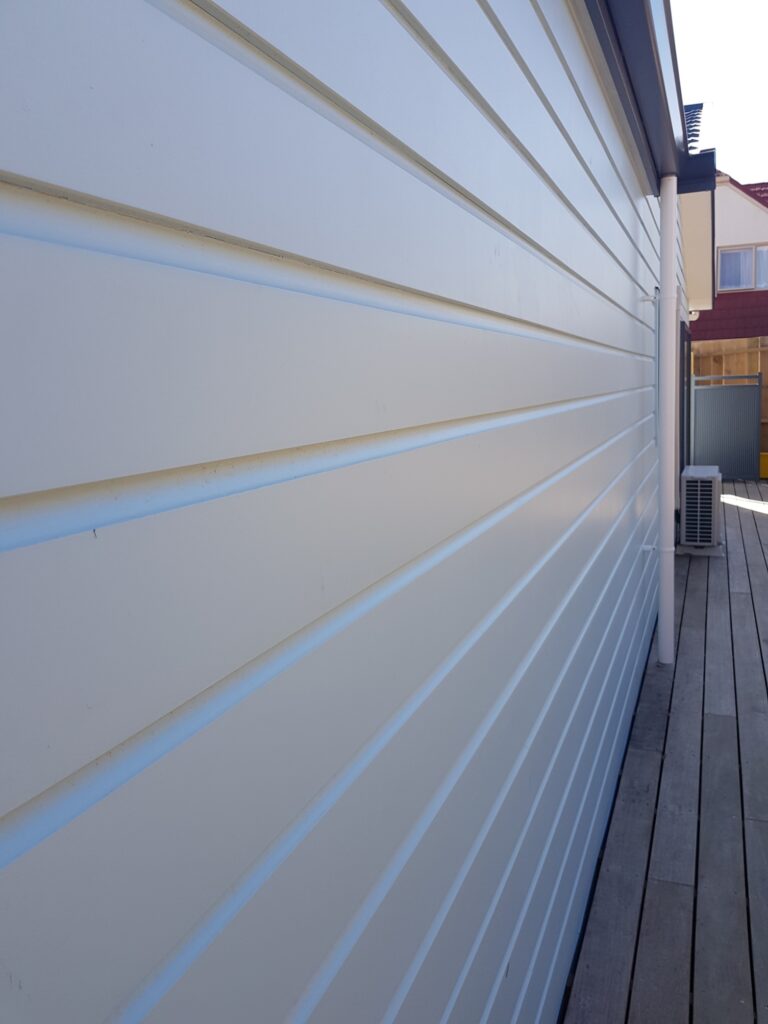recladding a House?
Looking at Recladding a house?
Looking to breathe new life into an older-style building?
The team at Style Plus Renovations North Shore Auckland take a look at what is involved with recladding a house and the associated costs:
Table of Contents

WHAT IS A LEAKY HOME?
If you are looking at recladding a house and have a monolithic plaster-clad home, there is a possibility that it suffers from an issue called “leaky home syndrome”.
This is an issue where water seeps through cladding junctions and cracks in the plaster. This may lead to hazards such as mould growth, which could damage the structural integrity of your home.
Recladding is often the ideal solution for a leaky home. Rather than undertaking minor remedial works to fix issues, a full reclad project gives you the chance to safeguard against water tightness issues, but also update your home’s exterior, and a great way to add value to your property.
DEFINITION OF RECLAD
The term reclad a house or recladding a house means to replace any part of the house exterior envelope (component or system) used on the outside of the building to prevent the ingress of moisture.
This process is regardless of whether the damage is immediately apparent or evident at the time of application, or whether the exterior cladding has met the durability requirements of the Building Code.
WHAT ARE THE COMMON CAUSES OF A LEAKY HOME?
During the 1990’s to 2004, there was poor design, poor building practices, substandard materials and a general lack of knowledge and trade skills in the building industry.
Included in this mix was a lack of consideration for the New Zealand weather conditions. This resulted in ‘leaky home syndrome’.
The majority of the leaky building issues have arisen in houses built with solid plaster cladding systems fixed directly to the timber framing (monolithic cladding). Monolithic cladding gives property exteriors a smooth, seamless look.
There are three main types of monolithic cladding:
- Stucco or solid plaster
- Texture coated fibre cement sheets
- Exterior insulation and finish systems (EIFS)
Once water gets behind direct-fixed cladding, the water becomes trapped in the wall structure as there is no drainage cavity. The drainage cavity became mandatory from 2004 for the majority of cladding systems.
On a side note, the leaky building issues is not just limited to monolithic claddings. There have been failures experienced in timber weatherboards, concrete blockwork and metal composite panels. Often due to the time taken for water to cause damage to the internal finishes. Homeowners are not aware that their home is suffering from leaks until ……………….
- Sagging of ceiling linings.
- Screws and nails that are rusty.
- Uneven floor surfaces. For example, lifting of flooring vinyl.
- Musty smells.
- Mould or fungi – although mould and fungi can be a result of poor ventilation.
- Swollen materials such as skirtings and architraves.
- Staining or discolouration of materials or surfaces.
- Stained or rotting carpet.
- Large cracks appear on the exterior wall plaster.
When recladding a house, the biggest unidentified reclad issue is that nobody knows the state of the timber framing until the cladding is removed
Jan Antoni Glinkowski – Style Plus Renovations - Director
Between 1996 and 2004 untreated kiln-dried framing timber was extensively used for building homes. This type of timber is highly susceptible to rot when moisture penetrates the building envelope. Since 2004, treated timber has become mandatory for timber framed construction.
When looking at the design features of the house, high-risk design factors associated with a leaky building need to be assessed. The list below is not exhaustive but can aid you to identify any design features that pose a significant weathertighness risk – if not properly installed and finished.
- Roofing
- Does the house have a complex roof design?
- Is the roof too flat with signs of water ponding?
- Does the roof butt into the wall cladding, creating a roof-to-wall connection?
- Aluminium joinery can also be a contributing factor in leaky homes. Moisture would often leak into the wall structure through poorly flashed window penetrations in the cladding system. Also moisture would leak directly into the wall structure through the aluminium joinery mitres
- Are the internal timber reveals showing signs of dampness, staining or damage?
- Are there any parapets?
- Do the window heads have slopes or curves?
- Are there any internal gutters?
- Decks
- Are there cantilevered balconies with timber joists penetrating the cladding?
- Are there waterproof membranes to decks with direct fixed tiles.
- Are there penetrations through the cladding such as pergola beams or rafters.
- Is there a balcony deck with an enclosed solid balustrade, with a waterproofed floor but with;
- no outlet and an overflow,
- solid balustrades with flat tops and no waterproofing.
- Is the floor level of the balcony deck less than 50mm below the level of the internal floor?
- Are the joists supporting the deck an extension of the house floor joists, without any visible saddle flashings at the cladding penetrations?
Note: E2/AS1 uses the term ‘decks’ to include both decks and balconies. It divides decks into two categories based on their water management characteristics:
- Spaced timber slat decks or other decks with a free-draining surface.
- Enclosed decks with an impervious or waterproofed upper surface and either closed in or lined underneath.
- Ground Clearance
- Does the current external cladding finish onto or into the ground?
- Cladding
- Are there penetrations by other building elements. For example, a side attached pergola?
- Are other cladding penetrations poorly flashed or sealed? For example, around mains power metre box or waste pipes?
- Are there signs of cracking of the plaster cladding?
DO I NEED BUILDING CONSENT TO UNDERTAKE RECLADDING A HOUSE?
A building consent is not required for a range of general building repairs, maintenance, and replacement of parts. However, replacing exterior wall cladding that has failed within 15 years of the cladding being installed, resulting in damage to the wall framing building consent is required.
Auckland council states that you will need to apply for building consent to carry out recladding work, even if the new cladding is the same as the one being removed.
CAN I LIVE AT HOME DURING THE RECLADDING PROCESS?
Well, it depends. In our experience when a full reclad is required and other renovation work is being carried out, we generally recommend that you do not live at home.
Typically, the house will be without cladding, insulation and joinery (windows and doors) for a period during the work. Also, the work required will be noisy, dusty and disruptive to the living environment.
BENEFITS OF A RECLADDING A HOUSE
However, after investing in a full reclad the benefits are there after the work is completed.
A full reclad will result in your home being brought up to the current Building Code E2/AS1 requirements.
A house reclad under a new Building Consent will mean you obtain a new Code Compliance Certificate (CCC) issued in respect of the work undertaken.
We offer a complete design-build package from the reclad design through to the final code of compliance certificate (CCC). This is typically the best option for most homeowners as it takes the stress out of the house reclad process.
COSTS OF RECLADDING A HOUSE
Recladding a house is still cost-effective, however, as a cautionary note, before you commence your project you need to have undertaken sufficient investigations to be satisfied that the house reclad project will not blow your budget once you start.
All building projects carry risks, the more unknowns the greater the risks, this is more prevalent when recladding a house...
Jan Antoni Glinkowski – Director – Style Plus Renovations
A simple one-level home will be more cost-effective to reclad than one with multiple storeys or a complex design.
The following points need to be assessed when considering the costs of a house reclad:
- What is the complexity and size of the house?
- What is the extent of the damage to the structure of the building? Also, is there any damage to the kitchen and bathrooms?
- Are additional renovation works to be carried out during the house reclad?
- Does the cladding contain asbestos?
- Does the house require new joinery such as doors and windows?
- Does the site have adequate access for deliveries and scaffolding?
As part of the house reclad process, once the cladding is removed and the framing is exposed, typically an independent timber consultant would be engaged to inspect the framing.
The consultant would tag timber that needs to be removed and any remedial work to be carried out.
For example, floor joists that are infected with rot and have lost strength need to be cut back to the point where the strength loss ceases to occur. Timber that has retained its strength but has fungi present will need to be treated.
The following is an estimate to the cost of recladding a plaster home;
When planning a house reclad project costs, there are a few key areas that we take into consideration. However, building work estimates are typically difficult to pin down at an early stage
- Reclad design allow $20,000
- Building Consent allow $15,000
- Consultant allow $8,000
- House reclad building work allow $220,000 – $650,000 (the higher end cost is a complex reclad)
When you are also contemplating changes to the interior it’s not uncommon to combine a house reclad project with a renovation project. This allows you to repair any damage to flooring, framing, balustrades or decks that are causing your weathertightness issues along with any internal renovations.
RECLADDING A HOUSE – PROCESS FOR A LEAKY HOUSE
At Style Plus Renovations, we believe that the process of identifying if there is a weathertightness / leaky building issue will require a careful and thorough investigation before any work commences. For example, this may start with a visual inspection and include invasive and destructive testing together with laboratory analysis of timber and cladding samples. Also, there may be a need to check/test to see if the current cladding or soffit lining contains asbestos. While the recladding a house process is similar to renovation work, the process for a leaky house will involve the Auckland council. There are specific meetings and inspections that need to be completed prior to the council issuing the Code Compliance Certificate (CCC). A typical process would be:- An initial onsite meeting with the client, project manager and consultant.
- An initial assessment of the work involved.
- A pre-construction site meeting with the Auckland Council to determine the scope of the work from a compliance requirement and other works that may be part of the renovation. ***
- A project-specific quality assurance programme (QA programme) is supplied with the building consent (BC) application which would include a quality assurance plan for identifying and removing decayed timber from the building.
- Additional meetings are scheduled with the council inspector, client, and consultant at various stages of the process. For example;
-
- For the removal of the original cladding.
- Prior to removal of damaged framing.
- After repair and prior to covering with building wrap.
- Cladding inspection.
- Painting inspection.
- Final inspection.
- Obtain the CCC from the council.
- The recladding work specific to the leaky home issue undertaken involves:
-
- Removal of the existing cladding.
- Removal of the building wrap.
- Frame and related structure assessment.
- Replacement of damaged parts.
- Treatment of the frame.
- Reinstallation of the new building wrap.
- Install new cladding.
- Where the applicant is engaged in the Financial Assistance Package (FAP) scheme.
- Certificate of Acceptance (COA) applications that include recladding.
- Building consent applications (including recladding) where the applicant is wanting to obtain a CCC for work more than five years old.
- Complex re-clad applications with an E2/AS1** risk score >12 including specific design.
- Over-cladding an existing cladding.
- Targeted or discrete repairs.
- E2/AS1 is an Acceptable Solution for Building Code clause E2 External Moisture. Following E2/AS1 provides one way of complying with Building Code clause E2.
- E2/AS1 addresses leaky problems in two ways:
-
- Providing details for common junctions and penetrations of the building envelope.
- Classifying buildings by their weathertightness risk, and requiring particular cladding solutions depending on the risk score.
-
FAQs - COMMONLY ASKED QUESTIONS FOR RECLADDING A HOUSE
- Where can I find information about my house?You can obtain your Property File from the local council. For Auckland you can order online. This file contains information relevant to a property, for example;
- Files of building consents or permits and associated drawings and documents.
- Inspection records and other relevant documents.
- What are weatherboards?Weatherboards are a type of cladding. They can be manufactured from timber, fibre cement, aluminium or PVC. The boards can be fixed horizontally or vertically. Also there different types of profiles available.
- How long does the reclad process take?Typically, allow 4 months (16 weeks), but due to the current materials delays this timeline can often take a lot longer.
If you would like to discuss options and ideas for your next renovation or reclad project contact us to be a free 1hr consultation.
Get started with a Free
Architects Renovation Feasibility Report
LET'S START
YOUR RENOVATION PROJECT
Tel us about your renovation project and we’ll call you back for a no-obligation chat about your ideas.
Alternatively, if you prefer, we can initially set up a meeting using Microsoft Teams or Zoom (and other meeting apps) for a no-obligation chat about your ideas.
We look forward to hearing from you to discuss your project and get you started on your renovation journey.
If you would like to know more about our renovation process, check it out here.

